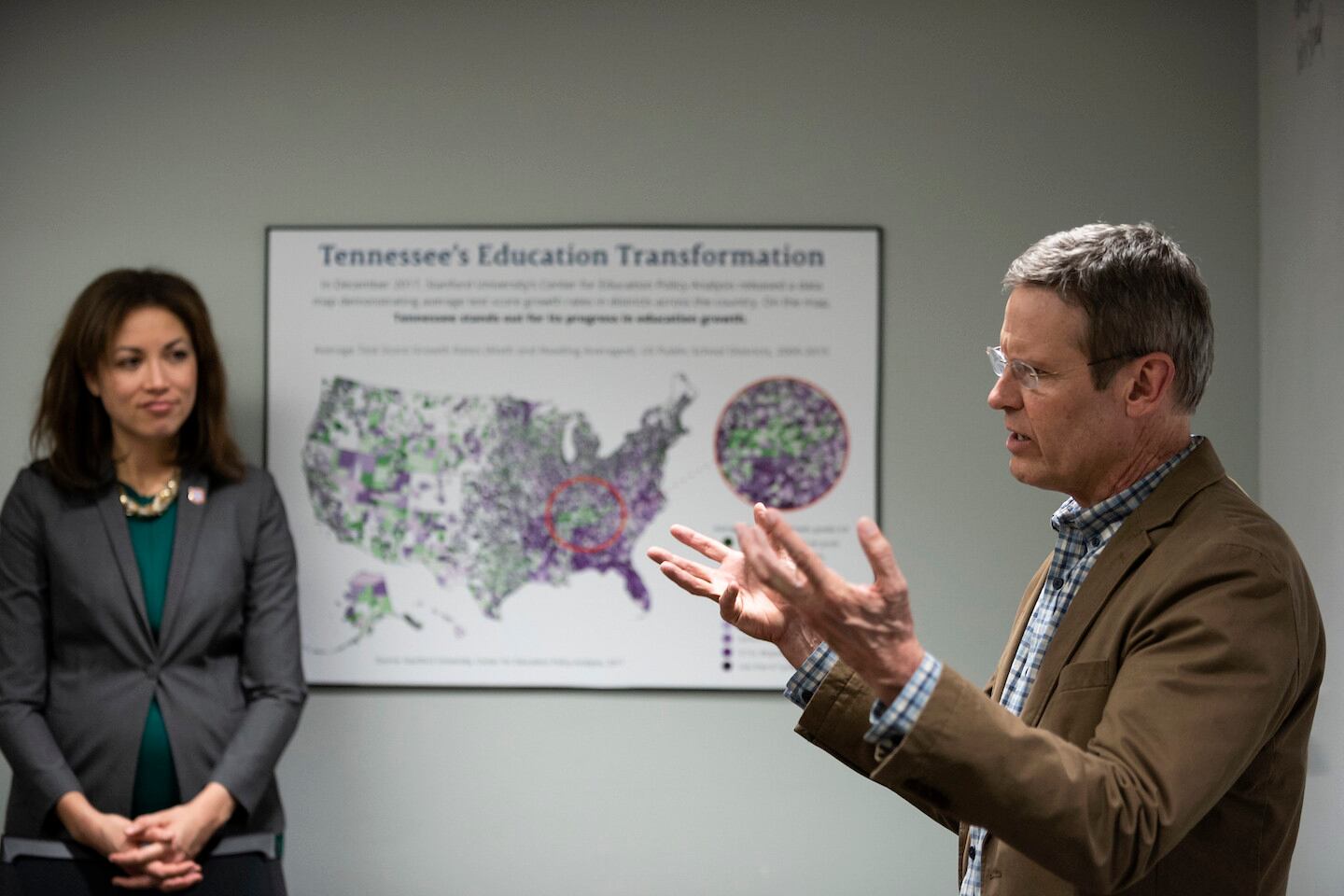A blueprint for overhauling Tennessee public education funding appears to align with Gov. Bill Lee’s pledge to consider each student’s needs and circumstances. But the big question is how much more money would be added to bolster learning for nearly a million students.
Lee wants a student-centered funding approach that would set a base amount of funding per pupil, then distribute additional money per pupil to support students in certain groups, especially those from economically disadvantaged families. Thirty-eight states use that model, or a hybrid that also includes separate funding for certain resources.
Tennessee’s would become a hybrid too, since the blueprint also calls for extra funding for programs like tutoring and career and technical education.
The four-page document, released this week by Education Commissioner Penny Schwinn, also recommends additional money to support the state’s neediest students, including those learning the English language, living in rural areas, or with disabilities.
Funding for school nurses and counselors — where Tennessee trails nationally recommended numbers and the pandemic has exposed huge vulnerabilities — would be part of the formula’s foundation, as would educator salaries, technology, and the state’s intervention program for struggling students.
Other funds would be set aside to tutor rising fourth-grade students who scored below proficiency on third-grade state tests.
“We’re encouraged,” said Gini Pupo-Walker, director of The Education Trust in Tennessee.
“But the devil’s in the details,” she added. “We know the state is going to put more money in. The question is how much, and will it be recurring?”
‘A unique opportunity’
The state’s 30-year-old Basic Education Program, or BEP for short, is a resource-based formula built around enrollment. Forty-six components determine how much school systems get from the state to pay toward teacher salaries and resources like textbooks, technology, and bus transportation.
Two former governors, Republican Bill Haslam and Democrat Phil Bredesen, failed at attempts to update or revise the BEP, which has been chronically underfunded and prompted a pending lawsuit against the state by nearly half of Tennessee school systems.
To reform education funding, conventional wisdom among policymakers and funding experts is that Tennessee must create a bigger pie — not just divide it differently — to avoid creating winners and losers. That’s especially significant in an election year, when Lee and lawmakers are asking voters to keep them in office.
With one of Tennessee’s largest budget surpluses in history, “the current budget landscape creates a unique opportunity” for a rewrite, the document said.
“This fiscal year, our state has taken in a billion dollars over what we budgeted due to economic growth, so we’re blessed and this is a real opportunity,” said Rep. Mark White, a Memphis Republican who chairs a House education committee.
Democrats say the formula may need updating, but that the foundational problem is inadequate funding. Many parents and advocates agree.
“One of the things I, as a parent, would like to see is just additional dollars,” said Venita Doggett, advocacy director of the Memphis Education Fund. “If we’re really going to support students, we have to make a concerted effort to increase the amount of dollars that flow to kids. It’s just not enough.”
Tennessee invests $5.6 billion annually in K-12 education, or just over $11,000 per pupil. That’s almost $4,300 below the national average and puts the state 44th in funding, according to the Education Law Center.
Last year, the group gave the state two Fs and a D for its funding level, allocation as a percentage of economic activity, and distribution, respectively.
Student-centered
The blueprint recommends weighting the heaviest funding for students living in poverty, moderate additional funding for students in rural areas, and light extra funding for the state’s 42,000-plus charter school students.
The amount of extra funding for students with unique learning situations — whether disabilities, giftedness, learning the English language, or qualifying for a Section 504 dyslexia plan — would depend on the need, according to the document.
JC Bowman, executive director of Professional Educators of Tennessee, was excited to see dyslexia on the list. “That’s a big issue, and a lot of students with dyslexia have gone underfunded for a long time,” he said.
The next phase of the conversation will be about how much extra funding to assign to each category of need, as well as the definitions used to count those students.
“At the end of the day, it’s about whether our highest-needs students are getting the resources they need to learn,” said David Mansouri, president and CEO of the State Collaborative on Reforming Education.
Mansouri called the framework “the right track.”
The blueprint also proposes setting aside more funds for fast-growing school systems and to bolster career and technical education, the latter of which has been a priority for Tennessee’s businessman governor, who has a mechanical engineering degree.
Charter school expansion is another priority for Lee, who has championed additional funding to pay for charter facilities each year since taking office in 2019. More than half of Tennessee’s charter school students are considered economically disadvantaged. Because the weighted funding is “stackable” — meaning that students could draw extra funding for multiple needs — those students could draw additional dollars for both categories.
Wish list
Other major costs are still under consideration. Among them: decreasing class sizes for Tennessee’s lowest grades and expanding the state’s program for pre-kindergarten students beyond the 22% of 4-year-olds who are now served.
Both needs have been discussed for years, but the pandemic has heightened the urgency of making impactful interventions in the early grades to address learning lag and support student mental health.
More than three-fourths of Tennessee school districts have waiting lists to enter pre-K. Meanwhile, the state’s pre-K program, which currently is funded outside of the BEP, hasn’t been expanded since 2007, and the funding level hasn’t kept up with inflation.
“We know the pandemic has exacerbated what was already a significant early learning crisis,” said Blair Taylor, president and CEO of Tennesseans for Quality Early Education. “Research repeatedly proves pre-K can help lay a critical foundation for education and life success, and it’s time for us to make better use of this tool.”
The wish list also includes career coaches for middle school students to guide them to the best options in high school. Others want any new formula to retool the salary schedule for non-educator school staff.
Tying funding to outcomes
The proposal outlines a per-student funding bonus for performance, especially for economically disadvantaged students, with five possible areas of measurement: literacy, college and career readiness, career and technical education, work-based learning and apprenticeships, and completion of the form for Free Application for Federal Student Aid, or FAFSA, to apply for financial aid for college.
Advocates say those areas need fine-tuning.
A big decision will be whether the state would measure reading improvement based on academic growth or proficiency. Tennessee’s current accountability framework is based on growth, which takes into account out-of-school factors like poverty that might hold students back.
“We’d like to see outcomes that incentivize growth, not just flat achievement,” said Pupo-Walker.
FAFSA completion is one of the more surprising components, since it’s not an indicator of college and career readiness. It’s just about who completes a form.
“This is not to say our proposal is the final draft,” Schwinn said Thursday to members of the governor’s 12-member steering committee reviewing feedback. “I’m giving you all the options on the menu.”
Looming questions
Much of the feedback so far has centered on concerns about what local governments would be expected to contribute, since the formula requires a local match.
Schwinn promised plenty of time for local officials to make adjustments. Any launch would require a year of planning and preparation. She’s also recommending a five-year “grace period” to give local funding agencies time to make adjustments.
But other questions loom.
Would school systems still have flexibility over how to spend the state’s allocation, as they do under the current formula?
Will Tennessee make teacher pay more competitive as its educator workforce shrinks?
And, should the state slow the funding conversation? After all, it took years to come up with the current formula, which has lasted longer than the people who created it expected.
“We cannot afford for Tennessee to fumble on a funding model in which our students could suffer,” said Leah Watkins, superintendent of Henry County Schools, a rural district in West Tennessee.
“It’s a heavy lift,” acknowledged White, the Republican education leader in the House. “But, if not now, when?”
Tennessee is asking for public comment on its draft summary by emailing tnedu.funding@tn.gov by noon, Jan. 18. More formation is available here.
The governor is expected to present any resulting proposal during his State of the State address on Jan. 31.





